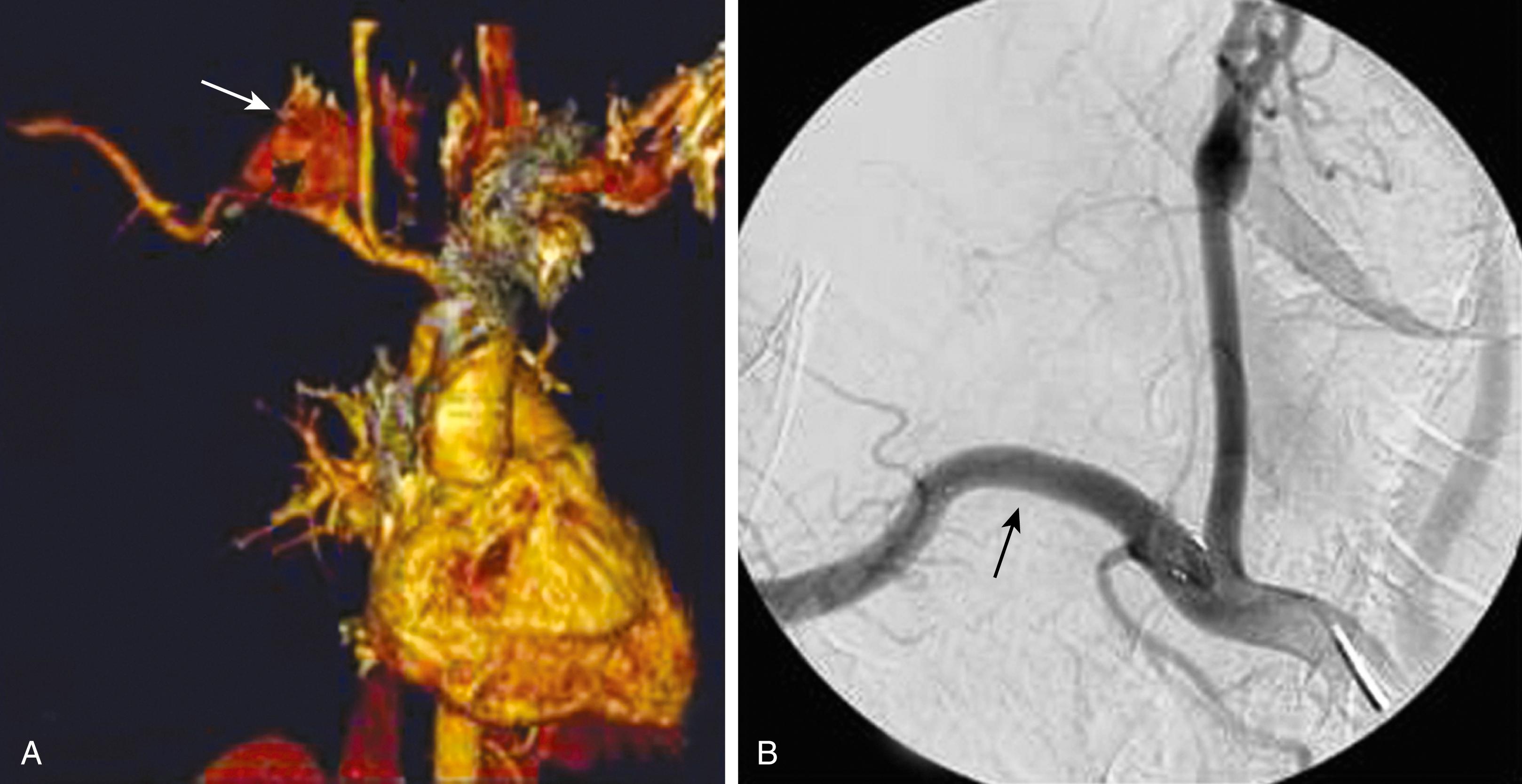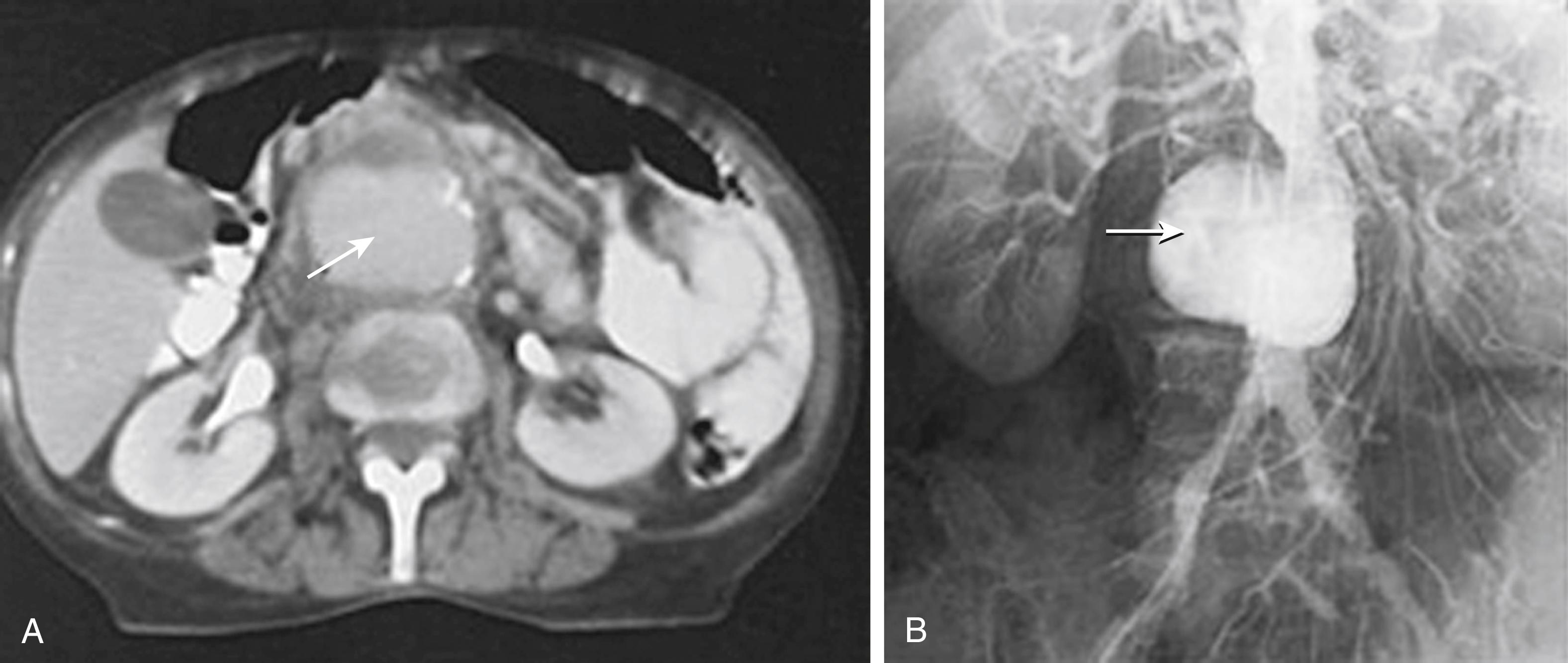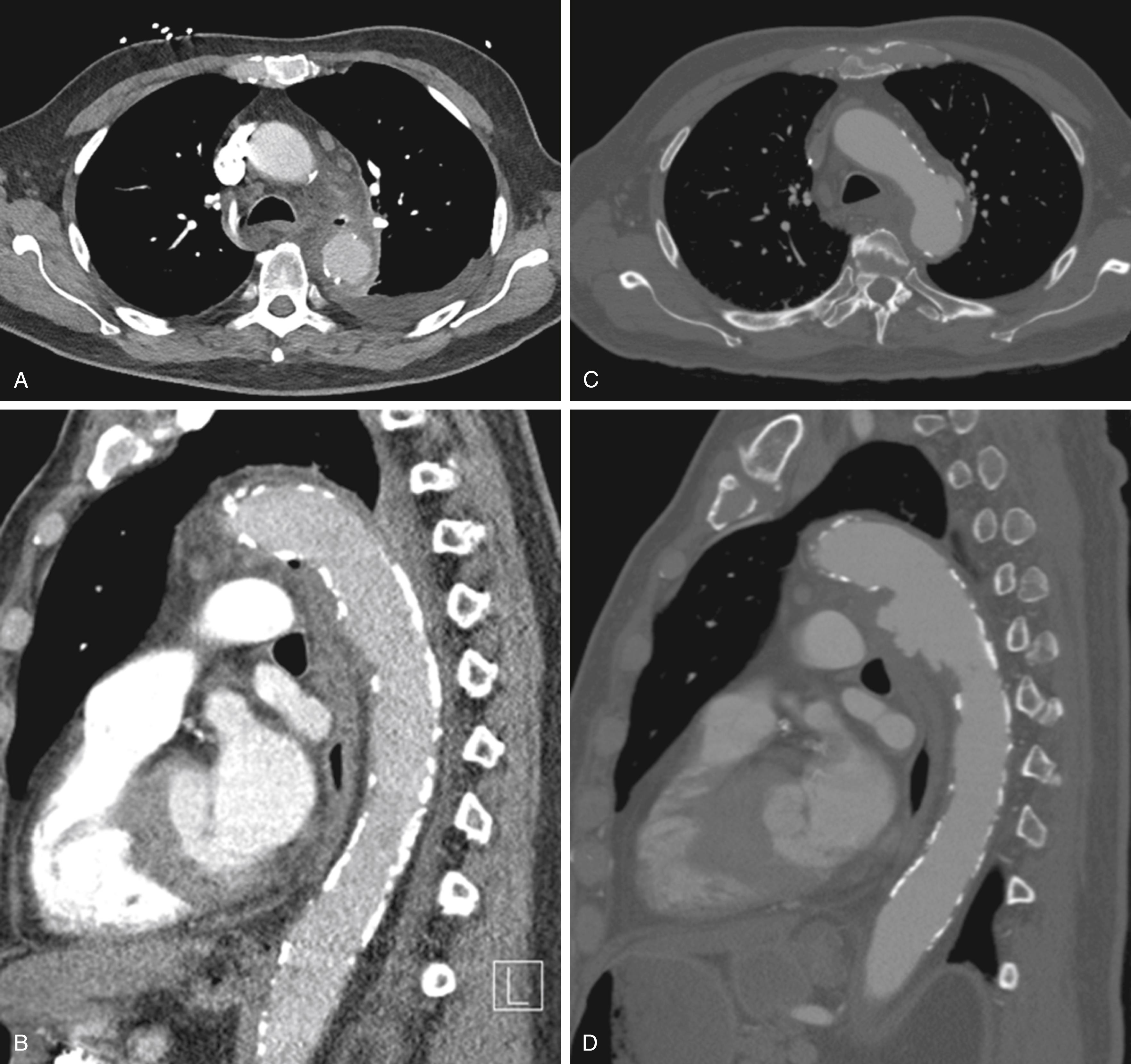Physical Address
304 North Cardinal St.
Dorchester Center, MA 02124
Management of infected arterial aneurysms remains a daunting surgical challenge. These infections can occur in any named vessel and often affect elderly patients with multiple medical comorbidities. Medical treatment alone with culture-directed antibiotics rarely eradicates the infection, and excision of the involved vessel with anatomic or extra-anatomic arterial reconstruction is usually required. Reports of using endovascular stent grafts as the primary treatment or a bridging therapy to arterial reconstruction have been published; however, the specific role of endovascular devices in the treatment of this difficult problem remains to be defined.
Osler in 1885 was the first to publish a comprehensive discussion of infected aneurysms. His series described infected peripheral arterial aneurysms in patients with endocarditis. In addition, his proposed pathogenesis included embolism of bacteria-laden material from infected heart valves to peripheral arteries resulting in destruction of the arterial wall. He termed the resulting aneurysm “mycotic,” since the eccentric saccular configuration resembled a mushroom. Unfortunately, this term led to confusion, with some assuming that it applied only to infections caused by fungi, and others applied the term to all infected aneurysms rather than just those associated with bacterial endocarditis. For these reasons, the term is best avoided.
In 1923, Stengel and Wolferth demonstrated that infected aneurysms could result from a variety of blood-borne septic conditions, not just endocarditis. Sommerville in 1959 reported a third type of arterial infection, one that occurred in preexisting atherosclerotic aneurysms. Later, infected pseudoaneurysms due to illicit drug use or iatrogenic arterial trauma were described. The overall incidence of infected arterial aneurysms has risen in recent decades with the increasing prevalence of immunosuppressed patients, invasive hemodynamic monitoring, catheter-based procedures, increasing use of cross-sectional imaging, and illicit drug abuse.
Infected arterial aneurysms are classified into four types based on etiology: (1) microbial arteritis with aneurysm formation due to noncardiac origin bacteremia or contiguous spread of a localized infection; (2) posttraumatic infected pseudoaneurysms, most commonly related to illicit drug abuse; (3) infection of a preexisting atherosclerotic aneurysm from bacteremia or contiguous spread; and (4) infected aneurysms from septic emboli, as classically described by Osler ( Table 145.1 ).
| Microbial Arteritis | Post-Traumatic Infected Pseudoaneurysms |
Infection of Preexisting Aneurysms |
Infected Aneurysms from Cardiac Source | |
|---|---|---|---|---|
| Etiology | Bacteremia, contiguous spread | Narcotic addiction, trauma | Bacteremia, contiguous spread | Endocarditis |
| Age | >50 years | <30 years | >50 years | 30–50 years |
| Incidence | Common | Common | Unusual | Rare |
| Common location | Aorta Iliac artery Intimal defects |
Femoral Carotid |
Infrarenal Aorta |
Aorta Visceral Intracranial Peripheral |
| Common bacteriology | Salmonella Others |
Staphylococcus aureus Polymicrobial |
Staphylococcus Others |
Gram-positive cocci |
Bacterial seeding can occur in nonaneurysmal arteries with preexisting wall irregularities caused by atherosclerosis or congenital abnormalities (e.g., aortic coarctation, patent ductus arteriosus). , Additionally, normal arteries can be infected by adjacent spread of a locally invasive infection. Once established, inflammation, suppuration, localized perforation, and/or pseudoaneurysm can result. Alternatively, more diffuse infection can result in rapid development of a true aneurysm, although often the aneurysm is saccular rather than a typical fusiform degenerative aneurysm. All named arteries are at risk, but the aorta is most commonly involved, likely due to its large intraluminal surface area and propensity for atherosclerotic involvement. ,
Conditions associated with microbial arteritis include diabetes, cirrhosis, chronic hemodialysis, posttransplant immunosuppression, human immunodeficiency virus infection, alcoholism, chronic glucocorticoid therapy, chemotherapy, and malignancy. , , In a study of 43 patients with infected aneurysms, Oderich et al. found that 70% of patients had at least one of the aforementioned immunocompromised conditions.
Arterial trauma leading to direct bacterial inoculation of the arterial wall can result in an infected arterial aneurysm. Bacteria can be introduced at the time of endovascular access or during drug abuse with inadvertent or intentional intra-arterial injection ( Fig. 145.1A and B). Notably, the use of percutaneous closure devices for endovascular procedures has been reported to be associated with infected pseudoaneurysms. , Not surprisingly, the common femoral artery is the most common location, but posttraumatic infected pseudoaneurysms involving the carotid, brachial, external iliac, and subclavian arteries have also been reported. , ,

Preexisting aneurysms can be secondarily infected by hematogenous or contiguous spread. Aneurysms are susceptible to infection, because the diseased intima or intraluminal thrombus presents a nidus for bacterial seeding ( Fig. 145.2A and B ). Interestingly, several studies have found that bacteria can be cultured from thrombus associated with asymptomatic degenerative aneurysms in up to 4% of patients and that aneurysms associated with bacterial growth in the thrombus may be more apt to rupture. , , Furthermore, Ernst showed that a greater number of positive cultures were found in patients with ruptured aneurysms compared with asymptomatic or symptomatic aneurysms (38% vs. 9% and 13%, respectively). Recent research has suggested the possibility that multi-bacterial infection in the aortic wall may be a contributor to the development of degenerative aortic aneurysms.

Currently, less than 10% of infected arterial aneurysms originate from endocarditis as classically described by Osler. , , Septic cardiac emboli may lodge in the lumen or occlude the vasa vasorum of the arterial wall, leading to ischemia and arterial wall infection. Once the artery is infected, rapid, focal, and progressive deterioration occurs and results in the characteristic saccular or multi-lobulated “mushroom-like” aneurysms. This process often leads to a locally contained rupture and formation of a false aneurysm. , Infected aneurysms associated with cardiac emboli are frequently multifocal, involving the aorta, intracranial circulation, and splanchnic and femoral arteries, typically at arterial bifurcations. , ,
The predominant microorganisms found in infected aneurysms depend on the type and etiology of the aneurysm, the patient’s geographic location and travel history, and their immune system. The bacteriologic spectrum is extensive and may be broader than was once believed. Staphylococcus species, of which many are methicillin resistant, are the most common organisms and account for 28% to 71% of cases. Salmonella species are the second most common and have been reported in 15% to 24% of patients. Streptococcus species account for less than 10% of the cases in the postantibiotic era. , , Overall, blood cultures are positive in 50% to 85% of infected aneurysm patients, and organisms have been isolated from aneurysmal tissue in up to 76% of patients with a suspected infected aneurysm. , , As endoluminal device implantation has increased, infection in an existing aneurysm and microbial arteritis has also increased. ,
Although less common, Gram-negative infections are more virulent than Gram-positive infections as demonstrated by rates of aneurysm rupture (84% vs. 10%) and patient mortality (84% vs. 50%). The increased virulence is postulated to occur due to the ability of Gram-negative organisms such as Pseudomonas aeruginosa to release alkaline protease along with a variety of elastases that cause vascular wall necrosis. Furthermore, Gram-negative organisms are commonly implicated in graft disruption and arterial stump hemorrhage after reconstruction. Consequently, the presence of Gram-negative organisms is an important consideration when contemplating repair strategies.
Methicillin-resistant Staphylococcus aureus (MRSA) has become an important public health problem. New strains of S. aureus with multiple resistant traits have been associated with high morbidity and mortality, and several recent series report MRSA as the predominant organism in infected aneurysms. In particular, infected arterial aneurysms with MRSA have been reported as the primary organism found in patients due to illicit drug abuse. ,
The diseased aorta appears to be particularly vulnerable to seeding by Salmonella species, and this pathogen is frequently found in infected preexisting aneurysms and in the infected atherosclerotic nonaneurysmal aorta. Specifically, Salmonella enterica accounts for more than half of reported cases of Salmonella aortitis. ,
Clostridia infections of the aorta have been reported as well. One species, Clostridium septicum , has a propensity to cause fulminant infected aortic aneurysms. C. septicum aortitis is often related to a gastrointestinal or hematological malignancy. The proposed pathogenesis involves microperforation of the gastrointestinal malignancy leading to hematogenous seeding in areas of the aorta with existing abnormalities, such as ulcerated plaque. , If not aggressively managed by wide debridement and reconstruction, the overall prognosis is poor with rapid deterioration of the aortic wall leading to rupture and death in 64% to 100% of patients ( Fig. 145.3 ).

Fungal infections, although rare, have been reported in patients with diabetes mellitus, immune suppression, and those with a history of systemic fungal disease. , , Reported fungal pathogens include Candida , Cryptococcus , Aspergillus , and Pseudallescheria boydii .
Treponema pallidum and Mycobacterium species have also been found in infected aneurysms. , T. pallidum (syphilis) once caused up to 50% of infected aneurysms but has become much less common since the advent of penicillin. Finally, tuberculosis (TB) is a rare cause and is generally secondary to erosion of TB-infected periaortic lymph nodes into the aortic wall. More recently, it has been reported that the use of Bacillus Calmette–Guérin (attenuated bovine TB bacillus) as an intravesical treatment for superficial bladder cancer has led to remote arterial infections involving the infrarenal aorta and popliteal artery. ,
Become a Clinical Tree membership for Full access and enjoy Unlimited articles
If you are a member. Log in here